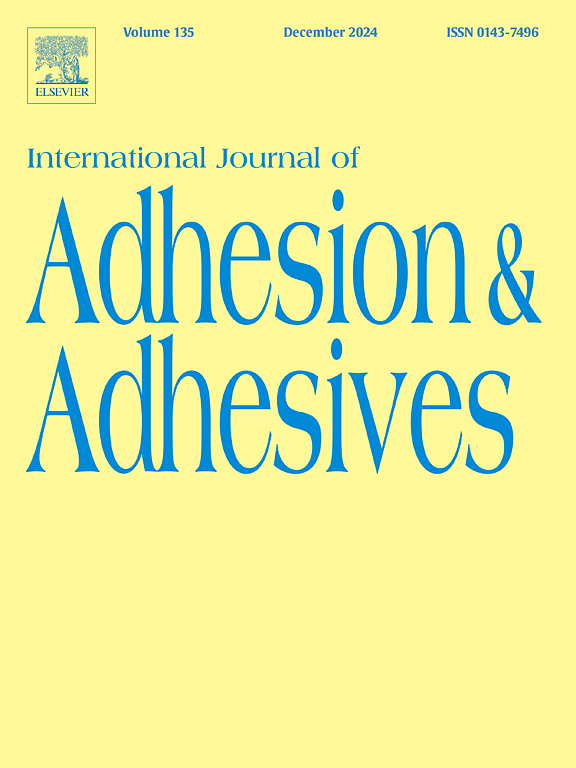汽车Al-CFRP复合材料管冲击破碎中的粘接:理论、实验和数值研究
IF 3.5
3区 材料科学
Q2 ENGINEERING, CHEMICAL
International Journal of Adhesion and Adhesives
Pub Date : 2025-07-24
DOI:10.1016/j.ijadhadh.2025.104112
引用次数: 0
摘要
研究了铝-碳纤维增强聚合物(Al-CFRP)复合材料管在准静态和冲击载荷作用下的耐撞性。该研究提出了一种提高汽车结构能量吸收的新方法。为了预测这些混合设计的平均破碎力,将复合材料的高强度和比刚度与金属的结构刚度相结合,建立并验证了理论模型。通过实验测试和有限元分析验证表明与理论预测高度一致。结果表明,纤维取向角、层厚和层数的增加均能提高碳纤维复合材料的吸能能力。开发了一个有限元模型来评估这些混合结构,重点关注五种不同的复合材料厚度角度:[+15/-15],[+45/-45],[90/90],[0/90]和[90/0]。复合层数从2到8层不等,同时考虑了均匀厚度和可变厚度。此外,采用α因子评价局部强化效应。研究结果表明,与铝材料或铝/复合材料吸能材料相比,局部增强(Al-CFRP)试件的粘接使复合材料通过符合铝的崩溃行为来增强吸能,从而形成一致的崩溃模式。加载速率对混合材料管和单材料管的变形模式影响最小。然而,在动荷载作用下,复合材料和碳纤维布管的吸能能力明显低于准静态荷载作用下的吸能能力。分析了冲击速度和叠加顺序对动态放大系数(DAF)的影响,该系数在简单的设计过程中很重要,因为它可以在不进行实际动态分析或试验的情况下从静态分析中估计动态影响。有趣的是,混合结构的DAF低于铝管,表明混合结构的横向惯性效应相对于空管减弱。本文章由计算机程序翻译,如有差异,请以英文原文为准。
Adhesive bonding in impact crushing of automotive Al-CFRP hybrid tubes: a theoretical, experimental and numerical investigation
This study investigates the crashworthiness of Aluminum-Carbon Fiber Reinforced Polymer (Al-CFRP) hybrid tubes, which are bonded with adhesive and subjected to quasi-static and impact loading. The research introduces a novel approach to enhance energy absorption in automotive structures. To predict the average crushing force of these hybrid designs, theoretical models were developed and validated, combining the high strength and specific stiffness of composites with the structural rigidity of metals. Validation through experimental testing and finite element analysis showed strong alignment with theoretical predictions. The results suggest that increasing the fiber orientation angle, the thickness of the layers, and the quantity of CFRP layers generally boosts the energy absorption capacity. A finite element model was developed to evaluate these hybrid structures, focusing on five different composite ply angles: [+15/-15], [+45/-45], [90/90], [0/90], and [90/0]. The number of composite layers ranged from 2 to 8, with both uniform and variable thicknesses considered. Furthermore, an alpha factor was applied to evaluate local reinforcement effects. Findings showed that in comparison to energy absorbers made from aluminum or aluminum/composite materials, the adhesive bonding in the locally reinforced (Al-CFRP) specimen enabled the composite to enhance its energy absorption by conforming to the aluminum's collapse behavior, resulting in a consistent collapse mode. It was also found that the loading rate has minimal influence on the deformation pattern in both hybrid and single-material tubes. However, the energy absorption capacity of hybrid and CFRP tubes was considerably lower under dynamic loading compared to quasi-static loading. The effects of impact velocity and stacking sequence on the Dynamic Amplification Factor (DAF) were analyzed, This factor is important in simple design procedure as it can be used to estimate the dynamic effect from the static analyses without con ducting actual dynamic analyses or tests. Interestingly, the DAF for hybrid structures was lower than that of aluminum tubes, suggesting that lateral inertia effects in hybrid structures are diminished relative to empty tubes.
求助全文
通过发布文献求助,成功后即可免费获取论文全文。
去求助
来源期刊

International Journal of Adhesion and Adhesives
工程技术-材料科学:综合
CiteScore
6.90
自引率
8.80%
发文量
200
审稿时长
8.3 months
期刊介绍:
The International Journal of Adhesion and Adhesives draws together the many aspects of the science and technology of adhesive materials, from fundamental research and development work to industrial applications. Subject areas covered include: interfacial interactions, surface chemistry, methods of testing, accumulation of test data on physical and mechanical properties, environmental effects, new adhesive materials, sealants, design of bonded joints, and manufacturing technology.
 求助内容:
求助内容: 应助结果提醒方式:
应助结果提醒方式:


